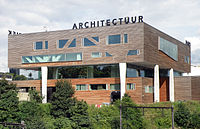File:Inleiding Barokorkest B'Rock (audio).mp3
Page contents not supported in other languages.
Appearance
Inleiding_Barokorkest_B'Rock_(audio).mp3 (MP3 audio file, length 28 min 35 s, 96 kbps overall, file size: 19.63 MB)
| This is a file from the Wikimedia Commons. Information from its description page there is shown below. Commons is a freely licensed media file repository. You can help. |
Summary
| DescriptionInleiding Barokorkest B'Rock (audio).mp3 |
Barokorkest B'Rock olv. Bejun Mehta Nederlands: Intrigeert het u ook om contratenor Bejun Mehta als dirigent aan het werk te zien? Van ons krijgt hij alvast sparringpartners eerste klas: topcellist Christian Poltéra en het schitterende barokorkest B'Rock. De eerste concerthelft is voor Joseph Haydn, die met het trage deel van zijn 'Trauer-Sinfonie' zijn eigen begrafenismuziek schreef. In het Eerste Celloconcerto gaat het er minder rouwig aan toe. Het werk is lange tijd verloren gewaand en werd pas in 1961 teruggevonden in het Praags Nationaal Museum. Haydn zette er de cello mee op de kaart als solo-instrument en bekrachtigde de classicistische conventies van het concertogenre. Het Divertimento voor strijkers in D, KV136, is eigenlijk Mozarts eerste Salzburgse symfonie. Hij schreef ze in 1772 toen hij als zestienjarige componist pas voor de nieuwe aartsbisschop Colloredo werkte. Alles boterde nog tussen die twee. Twee jaar later, bij het schrijven van zijn Negenentwintigste Symfonie, was de relatie beduidend minder goed: Colloredo had een hekel aan de eigenwijze Mozart, liet hem weinig reizen en gaf hem een onderbetaald baantje als concertmeester. Toen Mozart dan toch eens naar Wenen mocht, hoorde hij daar voor het eerst muziek van Haydn. Die werd zijn grote inspirator voor deze sprankelende symfonie. Français : Avez-vous autant envie que nous de voir le contre-ténor Bejun Mehta à l'œuvre en tant que chef d'orchestre ? Les partenaires que nous mettons à sa disposition sont de toute façon de premier plan : le grand violoncelliste Christian Poltéra et l'excellent ensemble baroque B'Rock. La première moitié du concert s'articule autour de Joseph Haydn, auteur de sa propre musique funèbre avec la partie lente de sa ' Trauer-Sinfonie '. L'ambiance est moins endeuillée dans le Concerto pour violoncelle n° 1, œuvre longtemps considérée comme perdue et retrouvée seulement en 1961 au Musée national à Prague. À travers cette œuvre, Haydn a assuré la position du violoncelle en tant qu'instrument soliste et a réaffirmé les conventions classiques du concerto en tant que genre. Le ' Divertimento ' pour cordes en ré majeur, KV 136, est en fait la première symphonie écrite à Salzbourg par Mozart. Il la composa en 1772, à seize ans, alors qu'il venait d'entrer au service du nouvel archevêque Colloredo. À l'époque, les deux hommes s'entendaient encore à merveille. Deux ans après, alors que Mozart écrivit sa Symphonie n° 29, l'entente n'était déjà plus au beau fixe. Colloredo détestait même Mozart pour son obstination et ne lui permettait que peu de déplacements ; il lui octroya un poste de maître de concert chichement payé. Lorsque Mozart put malgré tout faire un rare voyage à Vienne, il y entendit une première œuvre de Haydn ; ce compositeur fut sa grande source d'inspiration pour la symphonie pétillante. que vous entendez lors de ce concert English: Are you as intrigued as we are to see countertenor Bejun Mehta at work as a conductor? We've been sure to provide him with first class sparring partners: top cellist Christian Poltéra and the stunning baroque orchestra B'Rock. The first half of the concert is reserved for Joseph Haydn, who, in the slow section of his 'Trauer-Sinfonie', wrote the music for his own funeral. The First Cello Concerto is less woeful. For a long time, the work was thought to have been lost, and it was only rediscovered at the Prague National Museum in 1961. In this work Haydn put the cello on the map as a solo instrument, upholding the classicist conventions of the concerto genre. The Divertimento for strings in D, KV136, is actually Mozart's first Salzburg symphony. He wrote it in 1772 when, aged sixteen, he had just started work as a composer for the new archbishop, Colloredo. At first the pair got along well. But two years later, when he wrote his Twenty-Ninth Symphony, the relationship had soured: Colloredo disliked the headstrong Mozart, rarely allowed him to travel and gave him an underpaid job as a concertmaster. When Mozart was finally allowed to go to Vienna, he heard Haydn's music there for the first time. This became the great inspiration for this sparkling symphony. |
|||||||||||||||||
| Production Details InfoField | Symfonie nr 29 in A, KV201 (Wolfgang Amadeus Mozart); Concerto voor cello en orkest in C, HobVIIb:1 (Joseph Haydn); Divertimento in D, KV136 (Wolfgang Amadeus Mozart); Symfonie nr 44 in e, HobI:44 'Trauersinfonie' (Joseph Haydn) Nederlands: B'Rock Orchestra (muzikale uitvoering); Bejun Mehta (muzikale leiding); Christian Poltéra (cello) Nederlands: muziek Français : musique English: music |
|||||||||||||||||
| Source | deSingel, http://s3.eu-central-1.amazonaws.com/desingel-media/a1ib000000AICfMAAX.mp3 | |||||||||||||||||
| Author |
institution QS:P195,Q775025 |
|||||||||||||||||
| Permission (Reusing this file) |
https://desingel.be/en/info/copyright | |||||||||||||||||
Licensing
This file is licensed under the Creative Commons Attribution 4.0 International license.
- You are free:
- to share – to copy, distribute and transmit the work
- to remix – to adapt the work
- Under the following conditions:
- attribution – You must give appropriate credit, provide a link to the license, and indicate if changes were made. You may do so in any reasonable manner, but not in any way that suggests the licensor endorses you or your use.
Captions
Add a one-line explanation of what this file represents
Items portrayed in this file
depicts
File history
Click on a date/time to view the file as it appeared at that time.
| Date/Time | Thumbnail | Dimensions | User | Comment | |
|---|---|---|---|---|---|
| current | 22:11, 18 March 2020 | 28 min 35 s (19.63 MB) | NellBoey | pattypan 19.06 |
File usage
No pages on the English Wikipedia use this file (pages on other projects are not listed).

